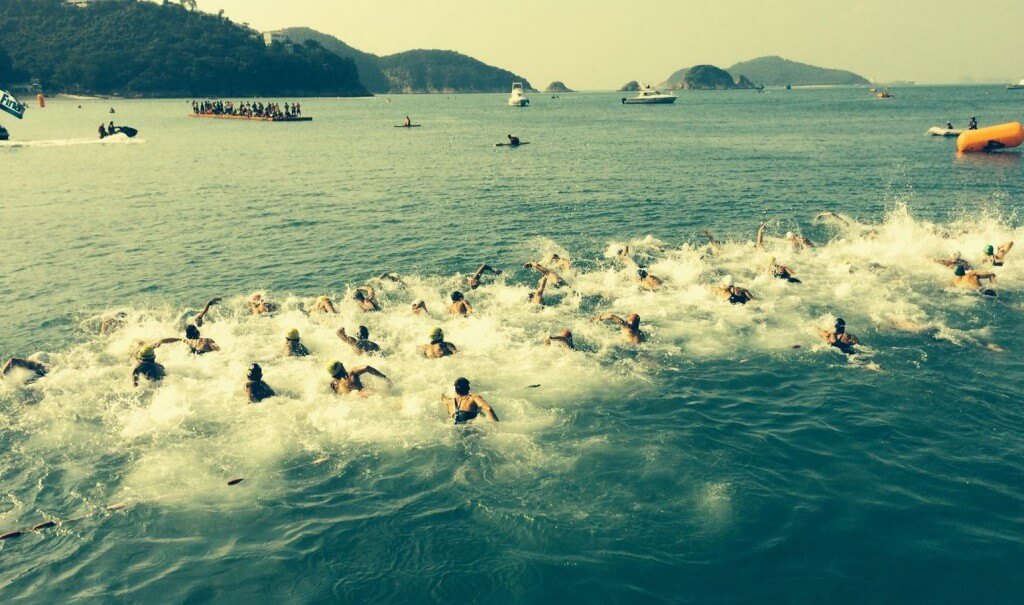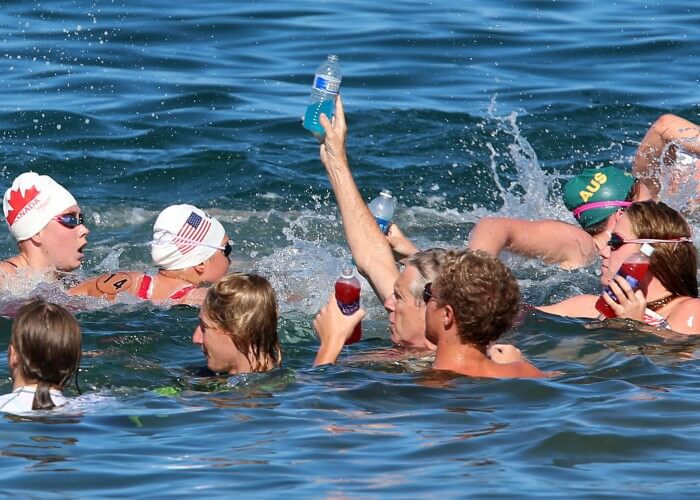How Hot Is Too Hot In Open Water Swimming?

By Dr. G. John Mullen
SANTA CLARA – Open water swimming dates back to Captain Matthew Webb in 1875, the first person to swim across the English Channel in 21 hours and 45 minutes covering a distance of about 34 kilometers. Since then, open water swimming has rapidly grown, attracting thousands of participants all over the world and even getting an event at the Olympics. The Federation Internationale De Natation (FINA) defines open water swimming as any competition that takes place in rivers, lakes, oceans, or water channels, and distinguishes between two categories on the basis of the distance swum. A long-distance swimming event includes any competition in open water up to a maximum of 10 kilometers, whereas marathon swimming events exceed that distance.
Recently, the United States and other countries have questioned the safety of open water swimming, specifically with heat stroke, medically known as hyperthermia. This resistance peaked at the 2010 FINA 10K World Cup race in Fujairah, UAE, with the tragic death of American open water swimmer Fran Crippen from what is believed to be hyperthermia. Recently, FINA announced the return of the 10K open water race to Dubai. Upon announcement, many athletes expressed their disdain, resulting in an increase in prize money in an attempt to change minds. This has resulted in the United States and others boycotting this race and Olympians questioning the motives of FINA.
The safety of open water swimmers is the utmost importance, which became crystal clear after Crippen’s death. This article attempts to remove the emotional strain associated with Crippen’s death — a swimmer whom I raced at national competitions — and reviews hyperthermia and how FINA decided on the current peak temperature limit of 31 degrees Celsius (87.8 degrees Fahrenheit). This article will not discuss Crippen’s death or the ethical opinion of having a race where a tragedy happened, but simply water temperature.
(Read the February 2015 issue of Swimming World Magazine to learn more about Crippen’s death and the aftermath.)
Swimming Heat Stroke
Hyperthermia is elevated body temperature due to failed body temperature regulation that occurs when a body creates more heat than can be dissipated. Hyperthermia is defined as a temperature greater than 37.5–38.3 degrees Celsius (99.5–100.9 degrees Fahrenheit). Normal human body temperature can be as high as as 37.7 Celsius (99.9 Fahrenheit) in the late afternoon. Hyperthermia is an elevation in body temperature beyond what is expected. Such elevations range from mild to extreme; body temperatures above 40 Celsius (104 Fahrenheit) can be life-threatening.
Heat stroke occurs when the core body temperature rises above 40 Celsius, and it is caused by the failure of the brain’s temperature regulatory center in the hypothalamus. Failure is caused by the inability of the body’s system to dissipate heat, inducing a dramatic rise in body temperature. This hyperthermic condition results in death of 20 percent of reported cases of heart failure or cerebral edema. Unfortunately, research of heat stroke in an aquatic environment is limited, but it is likely riskier, as nausea, fainting, dizziness, and vomiting are more deadly in the aquatic environment. Also, in the water, heat evaporation through dissipation doesn’t occur like it does on land. Moreover, convection and conduction are much greater in the water compared with land sports, increasing heat loss or gain during physical activity.
FINA Rules
FINA officials claim that the water temperature exceeded 31 Celsius (87.8 Fahrenheit) at the tragic 2010 10-km race (temperature recorded near race finish at 11:30 a.m.). Since then, FINA set the water temperature maximum at 31 Celsius. Macaluso (2013) supports this maximum temperature, since their research indicated pool swimming for 5K at 32 Celsius (89.6 Fahrenheit) only raised body temperature by 2 degrees to about 39.7 Celsius (103.46 Fahrenheit). However, many feel this is limit is too lenient as the maximum water temperature during pool competitions is 28 Celsius (82.4 Fahrenheit).
Open Water Differences
Once again, we don’t have excellent research on heat stroke in open water swimming, as the studies looking at heat stroke are performed in pools. Although swimming in a pool for a 5K at 32 Celsius (89.6 Fahrenheit) may be safe, open water contains these differences:
- Pool studies don’t have sunlight radiation.
- Pool water temperature don’t increase from increasing air temperature during a race.
- Elite open water swimmers typically have low body fat.
- Open water races are much longer than pool races.
- Elite swimmers can push closer to their physiological capabilities.
Therefore, open water maximum temperature limits must be lower than these studies. It is reported Crippen passed away in water reaching 31 Celsius, suggesting this is not a safe temperature. Some could argue Crippen’s case was an outlier, but with all the extra risks of heat stroke during open water swimming, a conservative maximum water temperature is mandatory. At face value, a water temperature maximum for open water swimming should be less than the pool temperature maximum. Personally, I feel a temperature limit of 26 Celsius (78.8 Fahrenheit)for 10K races and 27 Celsius (80.6 Fahrenheit) for 5K seems safest, if not lower based on the lack of open water research.
Many will feel these limits that I suggest are far too low, but a conservative water temperature is needed, as we don’t have enough research on the subject. Therefore, caution is key for the safety of the most important commodity within the sport: the athlete.
References:
- Macaluso F, Di Felice V, Boscaino G, et al. Effects of three different water temperatures on dehydration in competitive swimmers. Sci Sports. 2011;26:265–271.
- Macaluso F, Barone R, Isaacs AW, Farina F, Morici G, Di Felice V. Heat stroke risk for open-water swimmers during long-distance events. Wilderness Environ Med. 2013 Dec;24(4):362-5. doi: 10.1016/j.wem.2013.04.008. Epub 2013 Jul 25. Review.





Anything above 29-30c is dangerous for a prolonged swim
These are all valid points and need enforced by a governing body that cares more about athletes than money. Fina’s support for Dubai and Putin place their ability in doubt.
I appreciate the concern for water being too warm, but why is there no discussion about water being too cold. It is equally dangerous and equally hard to predict when someone will simply pass out.
This doesn’t even begin to address the issue of the brain eating amoeba in fresh water that we are faced with here in Florida. I’d be interested in temperature recommendations for that safety concern.
impresionante